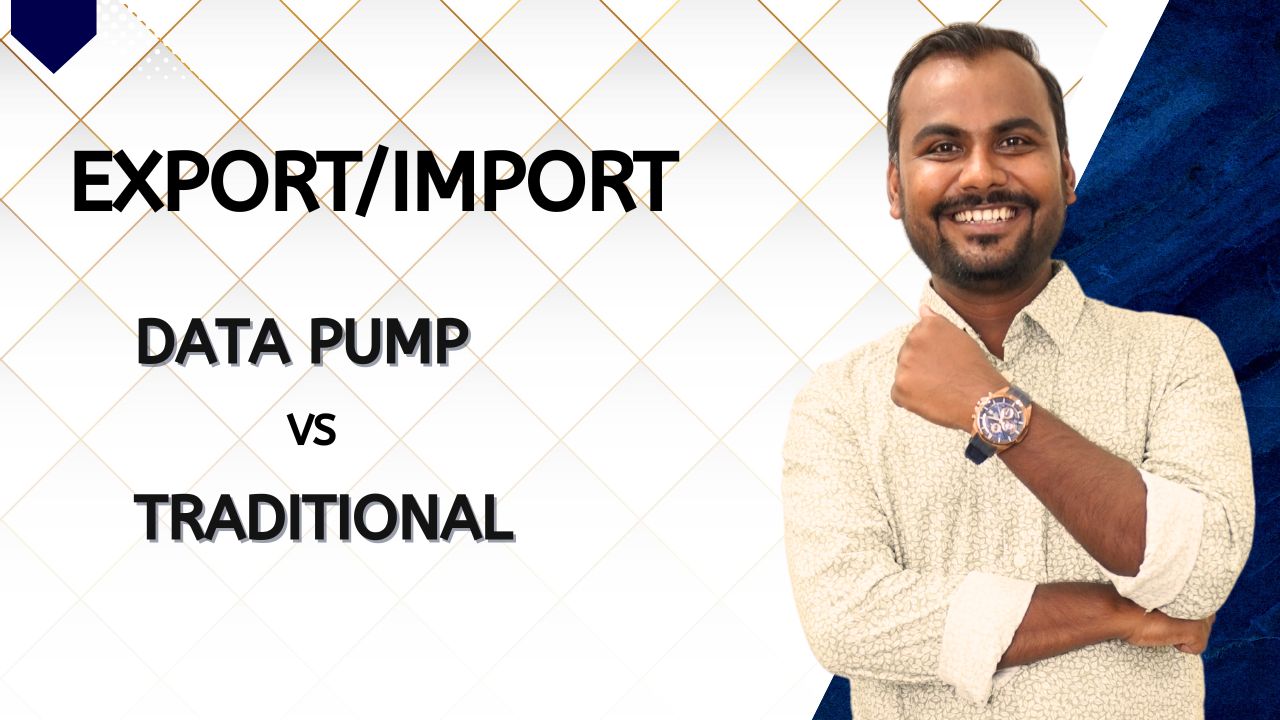Data Pump Export/Import vs Traditional Export/Import
Data Pump Export/Import vs Traditional Export/Import in Oracle DBA
As an Oracle DBA, database migration and backup are among the most critical tasks you perform. Oracle provides two primary methods to move data between databases — Traditional Export/Import (exp/imp) and the modern Data Pump Export/Import (expdp/impdp) utilities.
While both serve the same purpose — exporting data from one Oracle database and importing it into another — they differ significantly in performance, architecture, and flexibility.
1. What is Traditional Export/Import (exp/imp)?
The Traditional Export (exp) and Import (imp) utilities were introduced in older Oracle versions (pre-10g).
They are client-based tools that extract data from database tables and store it in a binary dump file.
Key Features:
- Operates at the client process level.
- Extracts data using SQL SELECT statements.
- Supports character set conversion during export/import.
- Commonly used for small to medium-sized databases.
Limitations:
- Slower performance due to SQL processing.
- Can’t take advantage of parallelism.
- Deprecated in Oracle 10g and later (though still backward-compatible).
2. What is Data Pump Export/Import (expdp/impdp)?
Data Pump Export (expdp) and Import (impdp) were introduced in Oracle 10g as a faster, server-based replacement for traditional export/import utilities.
Data Pump uses direct path and parallel execution, significantly improving performance for large datasets.
Key Features:
- Server-based architecture — runs inside the database, not through the client.
- Parallel processing for faster performance.
- Network mode for direct data transfer between databases.
- Supports fine-grained filtering (schemas, tables, partitions, etc.).
- Can resume jobs if interrupted.
3. Architectural Difference
| Feature | Traditional Export/Import | Data Pump Export/Import |
|---|---|---|
| Introduced In | Oracle 6 | Oracle 10g |
| Executable | exp / imp | expdp / impdp |
| Processing Level | Client-side | Server-side |
| Performance | Slower | 5–10x Faster |
| Parallelism | Not supported | Supported |
| Restartable Jobs | No | Yes |
| Filtering Options | Limited | Highly granular |
| Metadata Access | Through SQL | Through Data Dictionary views |
| Network Mode | Not available | Available |
| Compression | Not available | Supported |
| Encryption | Not available | Supported |
4. Example Commands
Traditional Export:
exp system/password@orcl file=backup.dmp full=y log=export.log
Traditional Import:
imp system/password@orcl file=backup.dmp full=y log=import.log
Data Pump Export:
expdp system/password@orcl full=y directory=DATA_PUMP_DIR dumpfile=backup_dp.dmp logfile=expdp.log
Data Pump Import:
impdp system/password@orcl full=y directory=DATA_PUMP_DIR dumpfile=backup_dp.dmp logfile=impdp.log
5. Advantages of Data Pump over Traditional Export/Import
- 🚀 Performance:
Data Pump is much faster as it uses Direct Path API and Parallel Execution. - 🔁 Job Restart Capability:
Interrupted jobs can be stopped and resumed without data loss. - ⚙️ Server-Side Processing:
Reduces client resource usage and enhances efficiency. - 🌐 Network Mode:
Enables direct export/import between two databases over a network — no dump files required. - 🔒 Security:
Supports encryption and compression, ensuring secure and optimized data transfer. - 🎯 Fine-Grained Control:
You can include/exclude specific objects, schemas, or tables using parameters likeINCLUDE,EXCLUDE, andQUERY.
6. When to Use Which?
| Use Case | Recommended Utility |
|---|---|
| Small, legacy systems (Oracle 9i or earlier) | Traditional Export/Import |
| Large databases requiring performance | Data Pump |
| Need to move data between servers | Data Pump (Network Mode) |
| Complex filtering or metadata movement | Data Pump |
| Backup for older systems | Traditional Export (exp) |
7. Real-World Scenario
Let’s say you’re migrating a 500 GB Oracle 19c database to another server.
Using traditional exp/imp would take hours and consume heavy CPU due to SQL processing.
However, using expdp/impdp with parallel=4 could reduce export time by over 70%, making it ideal for production environments.
Conclusion
Both Traditional Export/Import and Data Pump serve as powerful tools for data movement in Oracle databases.
However, Data Pump Export/Import (expdp/impdp) is the modern, optimized, and feature-rich solution for Oracle DBAs handling large data volumes and high-performance environments.
If you’re still using the old exp/imp utilities, it’s time to upgrade your data migration strategy with Data Pump.
Call to Action
Interested in mastering Oracle Database Administration and learning hands-on with real-time scenarios?
Join our comprehensive Oracle DBA Training Program at Learnomate Technologies — your path to becoming an expert DBA.
🌐 Visit: www.learnomate.org
🔗 LinkedIn: Ankush Thavali
📺 YouTube: Learnomate Technologies

